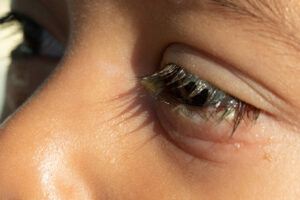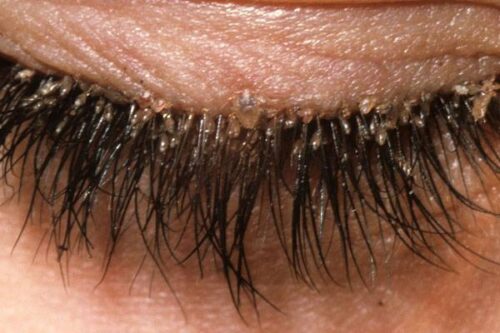While most people consider their eyes to be the windows to their soul, they might be surprised to discover that their eyelashes harbor an unseen world of tiny inhabitants – eyelash mites. These microscopic organisms, scientifically known as Demodex, have been quietly coexisting with humans for centuries.
Although seemingly harmless, recent studies conducted by doctors have unveiled an alarming truth: eyelash mites are far more common than previously thought, with a significant number of individuals unknowingly hosting these minuscule tenants on their lashes.
In this article, we delve into the world of eyelash mites and their symbiotic relationship with human hosts. Shedding light on this relatively unknown issue, we will explore the symptoms associated with eyelash mite infestations and their potential impact on ocular health.
By understanding these elusive creatures and recognizing the warning signs, readers can better protect their eye health and take proactive measures to maintain a clean and comfortable ocular environment. So, get ready to unravel the secret lives of these tiny inhabitants and learn how to keep your lashes free from unwanted guests!
Where Do Eyelash Mites Come From
Eyelash mites, also known as Demodex, are microscopic organisms that naturally reside on the skin and hair follicles of many mammals, including humans. There are two species of Demodex that primarily inhabit different areas of the body: Demodex folliculorum, which mainly lives in hair follicles, and Demodex brevis, which resides in sebaceous glands near hair follicles.
The exact origin of eyelash mites in humans is not entirely clear, but it is believed that they are acquired early in life. Most individuals are exposed to these mites during childhood, possibly through contact with an infected person or contaminated objects.
Demodex mites can be transmitted through direct skin-to-skin contact, making it relatively easy for the mites to spread between people.
Eyelash mites are generally harmless in moderate numbers and typically do not cause noticeable symptoms. However, factors like poor hygiene, compromised immune systems, or excessive oil production in the skin can lead to an overpopulation of mites, potentially causing skin and ocular issues. Additionally, as people age, their immune system may weaken, which could contribute to an increase in mite populations on the skin and eyelashes.
It’s important to note that while Demodex mites are common, not everyone will experience problems or symptoms associated with their presence. Maintaining good personal hygiene, particularly in the eye area, can help prevent an overgrowth of eyelash mites and minimize any potential issues they may cause.
What Are The Symptoms Of Eyelash Mites
Eyelash mites, or Demodex mites, usually do not cause noticeable symptoms in most people, as they exist in small numbers and coexist harmlessly with their human hosts. However, when there is an overpopulation of these mites, they may cause various symptoms, particularly if they affect the eyes and surrounding areas.

The symptoms of an infestation can include:
Blepharitis: This is a condition characterized by inflammation of the eyelids, causing redness, swelling, and irritation. When Demodex mites overpopulate the eyelash follicles, it can lead to a form of blepharitis called “Demodex blepharitis.”
Itching and Irritation: As the mites move around and consume oil and debris from the hair follicles, they can cause itching and irritation of the eyelids and the surrounding skin.
Burning Sensation: Some individuals with an infestation may experience a sensation of burning or stinging in the eye area.
Dry Eyes: Eyelash mite infestations can disrupt the natural oil balance on the eyelids, leading to dry eye symptoms.
Eyelash Loss: In severe cases, eyelash mites may cause the loss of eyelashes, as they can damage hair follicles.
Redness and Swelling: An overpopulation of mites can lead to inflammation of the eyelids, resulting in redness and swelling.
Crusting of the Eyelashes: Excessive mite activity and debris can cause the eyelashes to stick together, leading to the formation of crusts along the lash line.
Increased Tear Production: Some individuals may experience increased tear production as a response to the irritation caused by the mites.
It’s important to note that the presence of these symptoms does not necessarily confirm an eyelash mite infestation, as they can also be indicative of other eye conditions or allergies. If you suspect an infestation or experience persistent eye irritation, it’s essential to consult an eye care professional for a proper evaluation and diagnosis.
How To Prevent Eyelash Mites
Eyelid Hygiene: Practicing good eyelid hygiene is crucial in controlling mite populations. Regularly clean the eyelids and lash area using a mild, non-irritating cleanser. You can use a gentle baby shampoo or an eyelid-specific cleanser recommended by your eye care professional.
Warm Compresses: Apply warm compresses to the eyes to help loosen debris and reduce inflammation. Soak a clean, soft cloth in warm water and place it gently over the closed eyes for 5-10 minutes.
Eyelid Massage: After using a warm compress, gently massage the eyelid margins with clean fingers or a cotton swab. This helps to remove debris and dead skin cells.
Tea Tree Oil Treatment: Tea tree oil can be used as a natural remedy to manage Demodex mites. However, it’s essential to use it with caution, as undiluted tea tree oil can be irritating to the eyes. To make an around the eye oil, mix 1 drop of tea tree oil with 1 teaspoon coconut oil, then wipe on and around your eyelid with a cotton swab or soft gauze. Using 100-percent organic virgin coconut oil is your safest bet, as other products may contain ingredients that could cause irritation or an allergic reaction.
Click Here To Check Out Starwest Botanicals Organic Virgin Coconut Oil
Click Here To Check Out Starwest Botanicals Organic Tea Tree Essential Oil
Avoid Eye Makeup: During an active infestation or if you suspect mite-related issues, it’s best to avoid using eye makeup, especially mascara, as it can trap debris and contribute to the problem.
Replace Cosmetics and Tools: Regularly replace eye makeup, especially mascara, to prevent the buildup of mite debris. Clean makeup brushes and tools regularly to avoid contamination.
Wash Bedding and Towels: Regularly wash your pillowcases, towels, and sheets in hot water to reduce the chances of mite transmission.
Medical Treatment: In more severe cases or when home remedies are not effective, consult an eye care professional. They may recommend topical ointments, gels, or cleansers specifically designed to target Demodex mites.
It’s important to note that not all individuals with eyelash mites will require treatment, as these mites are usually harmless in moderate numbers. However, if you experience persistent eye irritation, redness, or swelling, or suspect an infestation, consult an eye care professional for proper evaluation and personalized guidance on managing eyelash mites effectively.
In Conclusion
In the hidden world of our lashes, tiny inhabitants known as eyelash mites, or Demodex, coexist with us, often unnoticed and harmless. However, when their populations grow unchecked, they can lead to uncomfortable symptoms such as itching, redness, and irritation, potentially affecting our ocular health. The revelation that eyelash mites are more common than previously believed underscores the importance of understanding and managing these minuscule creatures.
Fortunately, with proper eyelid hygiene and consistent care, we can keep Demodex mites in check and minimize their impact on our eyes and skin. Regular cleansing, warm compresses, and avoiding eye makeup during infestations are essential steps in maintaining a healthy ocular environment. For those seeking natural remedies, tea tree oil, when used cautiously and under professional guidance, may offer additional support.
However, it’s crucial to remember that not everyone with eyelash mites will require treatment, as these tiny organisms are often part of the natural balance of our skin. If you suspect an infestation or experience persistent eye irritation, it’s best to consult an eye care professional for a thorough evaluation and personalized advice.
As we continue to uncover the mysteries of the microscopic world, understanding the symbiotic relationship between eyelash mites and humans reminds us of the delicate balance that exists within our bodies. By shedding light on this lesser-known issue, we hope to empower readers to take proactive measures to safeguard their ocular health and embrace the marvel of our eyes’ intricate ecosystem.
So, let us not only appreciate the beauty of our lashes but also remain vigilant in preserving their well-being, knowing that even in the unseen corners of our bodies, the tiniest inhabitants can influence our health in surprising ways. Together, through knowledge and care, we can ensure that our eyes remain the true windows to our soul – clear, vibrant, and unhindered by the hidden world of eyelash mites.
Recommended Reading:





